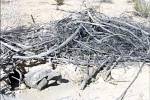Proper pruning will keep roses healthy
Pruning roses is necessary to produce high-quality flowers and keep the plants productive for years. Pruning also keeps them healthy, promotes new growth, removes unwanted canes and/or trains plants into desired shapes.
Today I'll present some basics on pruning roses, but pruning different roses can be hard to visualize. For a closer look, you might want to attend the Las Vegas Valley Rose Society pruning demonstration from 9 a.m. to 2 p.m. Saturday at 1112 Oak Tree Lane. These hobbyists will show you the basics and even let you prune a bush so you capture the important principles. For more information, call 646-6048.
You need to know the different types of pruning and when to prune. The popular floribunda, grandiflora and hybrid tea roses need heavy pruning during January when rosebuds begin swelling. Old-fashioned roses and climbers produce flowers on last year's wood. If you prune them now, don't expect any blooms this season, so prune them after they bloom. Even if you just about murder these bushes, they will recuperate to produce flowers next year.
There is one cardinal rule with all roses: Remove any dead, diseased or damaged wood on any rose at any time.
Prune with clean, sharp bypass hand pruners, loppers and a pruning saw. Dip these tools in a solution of isopropyl alcohol or Clorox to minimize disease transmission. And by all means, be sure to wear sturdy gloves, because rose thorns can get mean.
Certain pruning techniques are appropriate for all roses. First, remove any damaged wood and save the vigorous, healthy canes. Examine a cross section of canes to check for any sign of discoloration. You want white plump canes. Remove discolored canes down into healthy wood even if it means removing the entire cane.
Open the rose's center to increase air circulation and to stimulate new cane growth from the crown. Whenever two canes cross, remove one. Cut a quarter-inch above an outside facing bud on a 45-degree angle. New growth comes from the bud below this cut to further spread out the bush. During the summer, always remove spent flowers but make a diagonal cut just above a five or seven-leaf branch down on strong stems. Seal all large cuts with wood glue to prevent cane borer entry.
Hybrid teas, floribundas and grandifloras: Prune them hard if you want larger blooms and premium flowers. Eliminate all but three to five of the healthiest, most vigorous canes about 15 to 18 inches from ground level. Get rid of any spindly canes thinner than a pencil. In September, cut them back by about one-third of their height. This generates beautiful fall bloomers.
Climbing roses: Old-fashioned rambling roses and one-time spring-blooming climbers produce best flowers growing off 1-year-old wood. Cut away the oldest canes, leaving five to seven strong canes untouched. Remember, flowers come from 1-year-old canes on your climber, so the stems you save will bear next year's roses. Some climbers bloom on the current season's growth, so prune them more severely.
Old garden roses: They do not need hard pruning. If you do, it ruins their graceful shape and severely reduces flower production. Preserve their informal habit by removing no more than one-third of each bush. Normally, remove only the oldest canes. Most old roses bloom only once, so prune them after the bloom to keep them under control and vigorous.
Miniature roses: Trim them lightly or tip-prune several times a year, because they flower on new growth.
I could continue with more techniques, but instead here are some things to keep in mind: Never make a cut without a good reason. Try to understand how roses grow and produce flowers.
Finally, to get the latest information on how to prune right, attend the rose society's pruning workshop Saturday. They'll also cover fertilization, dormant spraying and mulching.
HERBS IN POTS
Growing Herbs in Pots will be the subject at noon Tuesday at the Sunset Garden Club at Paseo Verde Library, 280 S. Green Valley Parkway in Henderson. Master gardeners Jeanne Marie Toscano and Lisa Mosbey will show how to spice up your patio with herbs in containers. This event is free.
PRUNE DESERT LOVING ORNAMENTAL TREES
Prune with confidence. This workshop covers how to prune to train, maintain and improve growth in your desert adapted ornamental trees. The workshop begins at 8:30 a.m. today at the Springs Preserve, 333 S. Valley View Blvd. Call 822-7700 for more information.
Linn Mills writes a garden column
each Sunday. You can reach him at linn.mills@ springspreserve.org
or call him at 822-7754.























